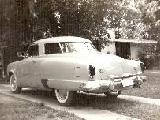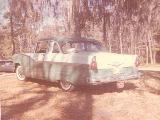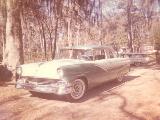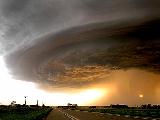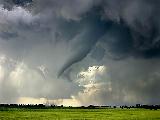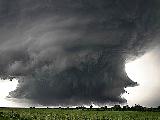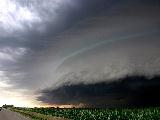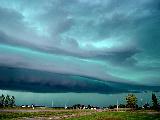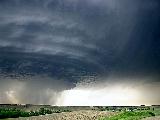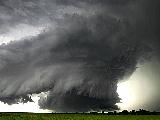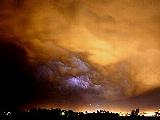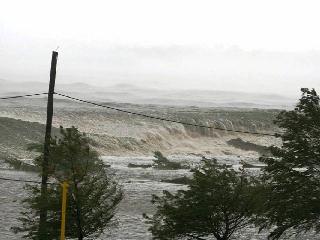If you read Chapter 46, you already know what Cruisin' the Coast is all about. A bunch of classic car buffs converge on the Mississippi Gulf Coast, cruise up and down US 90, admire each others cars, party a lot, and just have a generally fun get-together. Since MS is still recovering from Katrina (there's more on Katrina further down this page), I didn't know if they'd still have it or not, but ... I just happened to be there the first week of October, 2006, and there they were! I was in the midst of a little 3000-mile trip from Florida to Texas and back, and had stopped in MS for a few days. I just happened to be wandering through the Biloxi area and bumped into them. I took a few photos, but not nearly as many as back in that earlier chapter. I figure I've got enough photos of the most popular classics spread all over this website, so I took some of the more interesting and unusual cars (IMHO).
First below is a 1951 Ford hard-top. I've always liked the '51 Ford and you seldom see one in a show. You very rarely see a hard-top - I think this might have been the first year they came out with the hard-top. For those of you too young to remember, the hard-top had no center-post between the front and back - I think they stopped making them, because they didn't pass safety regulations.
Next is the 1951 Studebaker Champion - exact replica of my first auto! To the right, I included an old photo of my Stude for comparison. You might note that mine was "customized" - my brother was big into removing hood/trunk ornaments and filling in with Bondo or fiberglass. I eventually took off the bumpers, painted flames on the front, etc., but have no photos of that.
My Travel Log
Nothing in this site is copyrighted -- I'd be honored if you'd reuse anything you find here for your website
Click any photo for a larger view
78. Cruisin' the Coast - 2006
1951 Ford hard-top
1951 Ford hard-top again
1951 Stude Champion
My First Car - in the front yard on ChockSacka Nene in 1956
1955 Ford Crown Victoria
'55 Ford again
1956 Ford 2-Door Sedan
My Second Car - in the front yard in about 1960
My Second Car - again
Below, more photos of cars I found to be neat! The first car I ever rode in at over 120 mph was a 1955 Ford Crown Victoria belonging to Tommy Stoutamire. I was in the back seat, but still an amazing experience! Next over is a 1956 Ford 2-Door Sedan, just like my second car, except mine was Green instead of Brown (or Red, or whatever that is). To the right, some old photos of mine - kinda faded, but still viewable. Note the Coasters Car Club tag hanging on the rear bumper - a necessity in the 1950s. Also note the absence of bumper guards, front and rear, plus the lack of vertical bars in the grille. Also had spinner hub caps and fender skirts. Just the beginnings of customization that we did back then. Below that, a couple more cars that aren't often seen in shows, then my favorite, a chopped, channelled, customized 1949-1951 Mercury (can't hardly tell the difference).
1956 Studebaker Hawk
1958 Chevrolet hard-top with 348ci engine and continental tire kit
So much for Cruisin', now a little bit about Katrina. It's been just over a year since the hurricane hit the MS coast and I was really curious how it would look. I was amazed to find that almost nothing remains on much of the coast. I'd been thru there after some bad hurricanes in the 1960s, but this was much worse. Below, I've included some current photos. Way down at the bottom of the page, I put some photos that were emailed to me, showing the hurricane in action.
First, Atchafalaya Swamp, has nothing to do with Katrina. Whenever I come across the long bridge over the swamp, I always think how neat it looks and how I want to take a photo - this trip, I just held the camera up and snapped. Really a desolate-looking place, with Cypress stumps as far as the eye can see.
The first thing that caught my eye when I got to the beach was at this stoplight. I looked out and all I saw was a Waffle House sign and, further along, an Outback sign. This must have been all businesses ... now, nothing but a couple of signs. The only things remaining of most of the homes within a few blocks of the beach are a driveway and a slab. There are many, many that look just like this. One had just the fence remaining, but little else. Further down, a McDonald's sign is the lone reminder of what once was.
In the next row, just some photos of the few structures that made it, mostly just a shell of the former building.
Atchafalaya Swamp
Another view of the remains of the church
Church frame made it
Just a fence to show where a home once was
Another view of "shell" house
Only a few houses remain, mostly just a shell like this one
Slab and driveway where home formerly was
Site of McDonald's
1949 (or 50 or 51) Mercury
La Fiesta Brava was a rather large restaurant, as I recall
Very popular souvenir shop
That frame is where the giant Shark's head was
US 90, where there formerly were Waffle House, Outback, and many more businesses
Was solid businesses from Waffle House way past Pink building
Below, an area where Al Wulff and I spent quite a bit of time on our 2003 trip through. Al ate at Waffle House every morning while we were there. That Pink building was our landmark that let us know we were almost to the RV park. There was a giant Shark's head out front that could be seen from several blocks away.
Below, some Katrina photos I received in a recent email. Here's the text from the message:
Photos of Katrina over Mississippi
These pictures were made by a man in Magee , MS where the eye of the storm passed thru - what an experience. Magee is 150 miles North of Waveland , Mississippi where the Hurricane made land fall. Worth passing on!!! The dance with Katrina, part of her beauty as she left destruction on her exit. They are remarkably dramatic.
The following picture was taken from the third story balcony of Saint Stanislaus College located next door to Our Lady of the Gulf church in Bay Saint Louis, Mississippi on the morning of August 29th, 2005. This is believed to be the initial tidal wave from Hurricane Katrina. The tidal wave was approximately 35 to 40 feet high. When it slammed into the beach front communities of Bay Saint Louis and Waveland Mississippi, it completely destroyed 99% of every structure along the beach for 9 miles and over a half of a mile inland. The destruction only started there. The flooding that continued inland destroyed the contents of all but 35 homes in these two communities of approximately 14,000 people.



